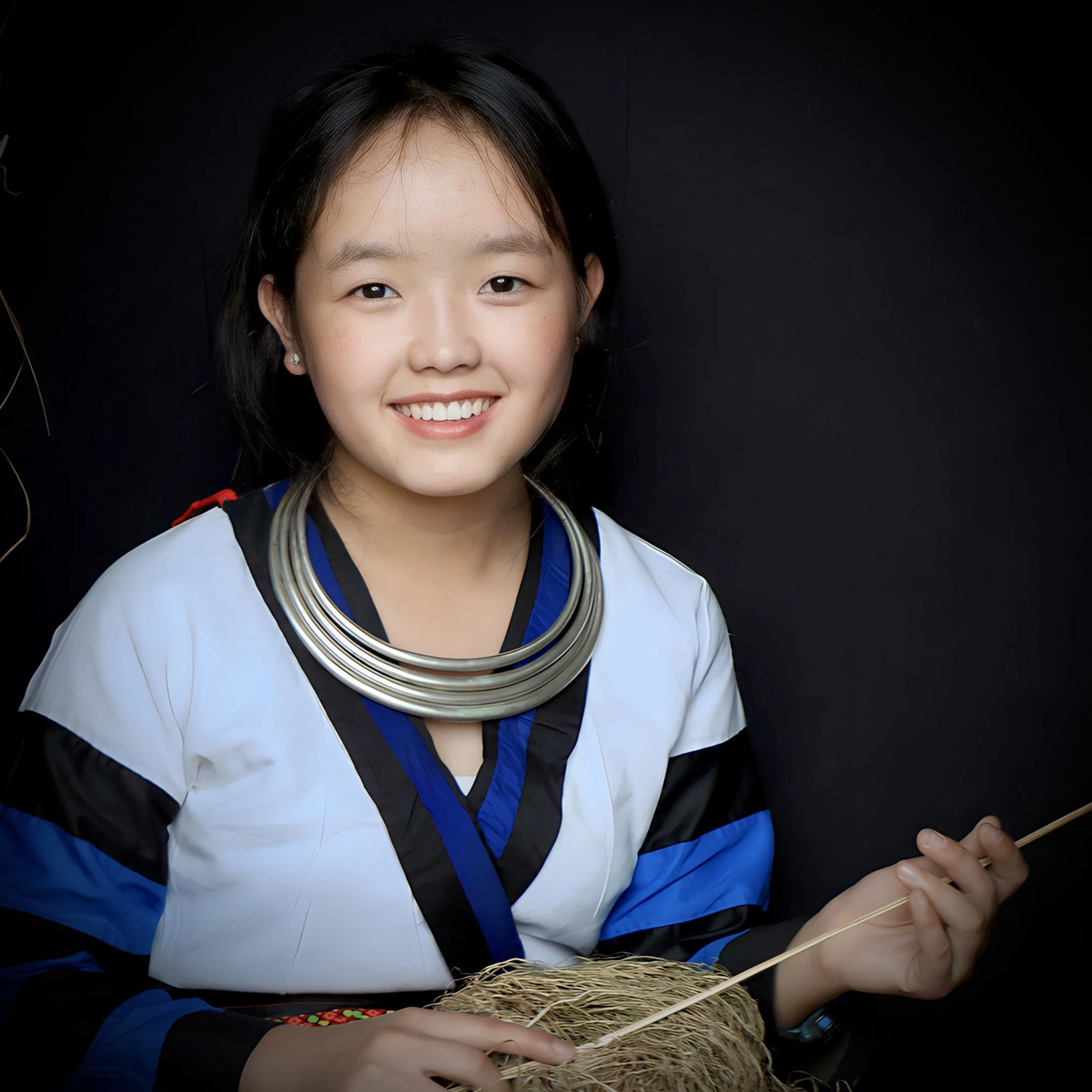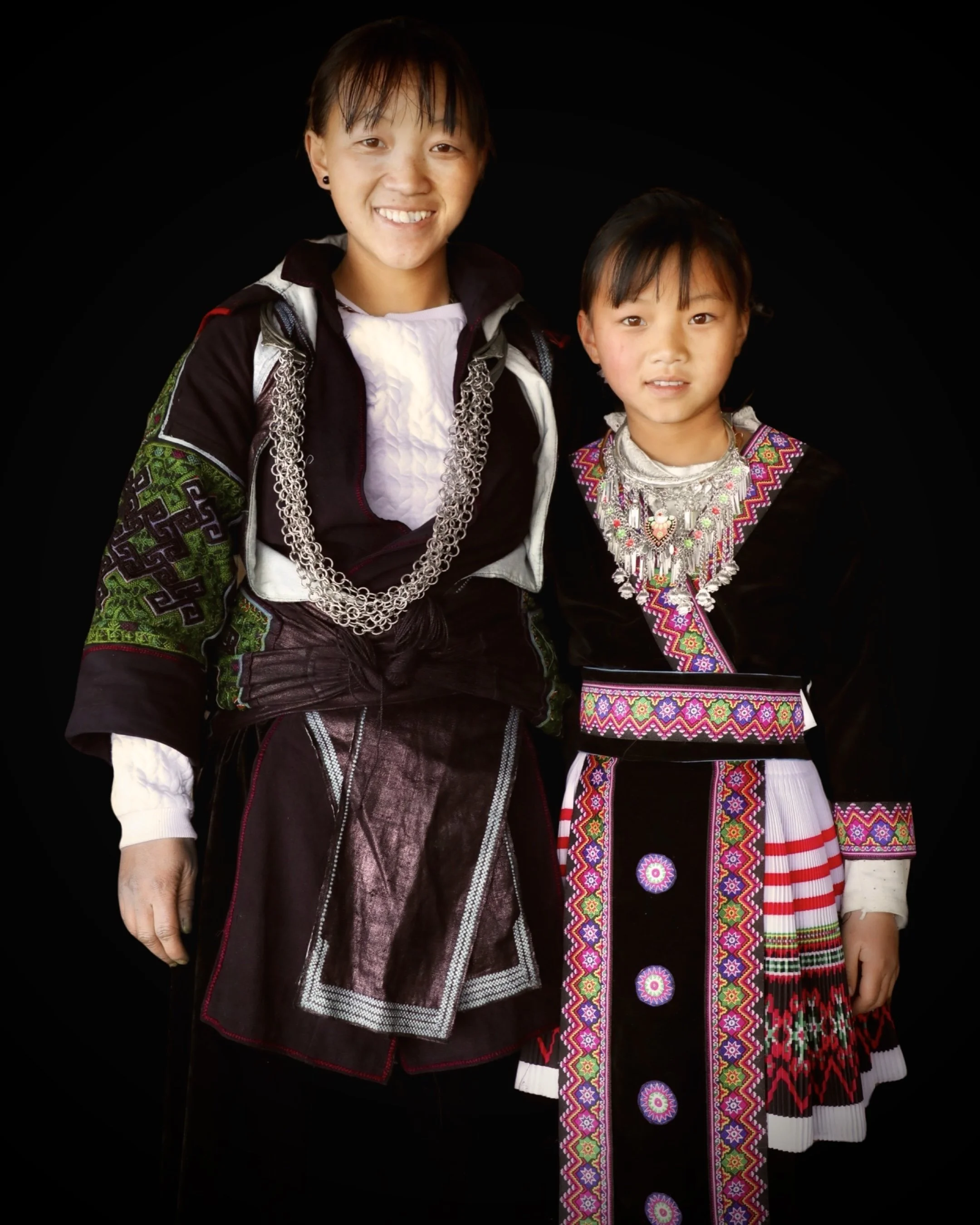
Hmong Clothing in Northern Vietnam: Indigo, Thread, and Story
A living wardrobe
Clothing in Hmong communities is not only what one wears; it is a way of telling a life. Patterns record journeys across mountains, colour marks moments of celebration, and even the scent of indigo settles into memory. The wardrobe is living, practical, and beautiful. It changes, of course, as all clothing does; yet the heart of it remains handmade fabric, patient dye, and careful stitch.
We work with Hmong partners in Sapa and along the border belt. They are farmers and artists, mothers and clan leaders, young embroiderers learning from grandmothers, guides who are not simply guides. When they welcome travellers into their homes, clothing is part of the welcome; a quiet introduction before the first cup of steaming tea.
Indigo and hemp: from field to fabric
Hemp is planted on steep fields, then harvested, retted, and beaten until fibres loosen. Strips are hand spun into yarn; the rhythm can feel almost meditative, though there is hard work in every metre. The yarn is woven on simple looms into cloth that starts pale and coarse, then softens with use. It is a fabrik that is hardy but feels cool even in summer.
Indigo grows close by. Leaves are fermented to release the dye, then stirred to life in deep vats. A length of cloth is dipped, lifted, and dipped again; colour builds slowly, layer upon layer, until a blue so deep it appears black in low light. The smell is distinctive, earthy and slightly sweet.
The process of turning indigo leaves and hemp fibres into fabric is more than craft it’s heritage. Come stand by the vat, feel the texture of hemp, and see the colours come alive. [Try an Indigo Experience]
Growing and preparing hemp
Seed selection, soil tending, and harvest timings are local knowledge. Techniques vary between valleys; some families beat and polish the finished cloth with smooth stones until it shines softly. Others prefer a matte finish that feels more durable. There is no single right way; just families and their preferences.
Dyeing with indigo
The dye vat is alive. It needs warmth and rest, careful feeding, and quiet attention. Cloth is dipped many times, with pauses to let oxygen fix colour. Patience shows in the final tone; a hurried piece looks pale, while a patient one is rich and deep in colour.
Wax, line, and pattern: batik as a language
Before dyeing, many Hmong artists draw with beeswax on the cloth. The wax resists the indigo, leaving white lines where wax sits. A bamboo or metal-tipped tool is used to draw; hands steady, breath steady. Motifs repeat: stairs of mountains, spirals that hint at seeds or storms, borders that hold the world in balance. Patterns carry meanings, but meanings are not fixed. The same motif can be read as a path, a river, or a family line. People will disagree, gently, but every artist cretes their own story.
Every motif tells a story, but it makes even more sense when you see it created by hand. Sit beside a Hmong artist and watch wax, cloth, and thread transform into memory. [Join a Batik Workshop]
Tools and motifs
The tool leaves a line that is slightly uneven, which is part of the beauty. Grids, crosses, snail-shell curls, tiny squares, and interlocking paths appear in endless variations. Some motifs stay with one clan, others travel between villages like stories do.
Threads that speak: embroidery and appliqué
Embroidery is known as paj ntaub, the flower cloth. Threads are bright; fuchsia, saffron, leaf green, sky blue. On indigo, these colours sing. Hmong makers piece and fold, tuck and stitch, then embroider in counted patterns that seem to move when you step back. Appliqué adds layers; narrow bands of brocade are woven on backstrap looms and attached to cuffs or hems.
Bright threads and careful stitches turn cloth into storytelling. If you’d like to learn a few stitches yourself, our embroidery experiences welcome beginners with patience and joy. [Learn Hmong Embroidery]
Stitches and symbolism
Cross-stitch is common, but there are many stitches for edging and joining. Motifs echo those in batik, yet the feel is different; softer, perhaps more playful. Some say a certain spiral protects a child; others say it celebrates growth. Both can be true.
Dressing the day: what is worn and when
Daily wear is practical; festival wear is radiant. Women often wear an indigo jacket or tunic, a pleated or straight skirt depending on subgroup, an apron, and a sash. Leg wraps protect calves on steep trails. Men wear indigo jackets and trousers that allow easy movement for farming and riding. Silver jewellery is treasured; bangles that chime softly, earrings that catch the light, and heavy neck rings that are sometimes inherited.
Clothing in Sapa is not just worn it’s lived. Festivals, farming, family life: each moment has its attire. Walk through the markets with us, and let the clothing come alive in its setting. [Experience Sapa With Us]
Women’s attire
A fitted jacket, embroidered cuffs, a batik panel at the back, an apron at the front. A wrap belt pulls everything into place. For festivals, the colours intensify, and more silver appears. The weight feels ceremonial, and it is.
Men’s attire
A straight-cut jacket, sturdy trousers, a hat or headscarf. Details vary; a pocket edge, a stitched collar, a bit of bright thread that quietly resists the idea of plainness.
Children and baby carriers
Baby carriers are artworks in their own right; padded, embroidered, and practical. They keep child and caregiver close on terraced fields and narrow paths.
Variety across Hmong communities
Northern Vietnam is home to many Hmong groups, each with distinct dress traditions. In some valleys you will see pleated skirts that move like water; in others, straighter skirts or trousers with panels of batik. Headwear changes too; turbans, peaked hats, or bright ties. A traveller can learn to recognise these differences, but perhaps not quickly. That is fine; learning takes time.
Making; mending; wearing longer
Garments are repaired as a matter of course. Patches become part of the story, turning elbows and knees into small galleries. Indigo deepens with washing and sun. You will notice how a well-loved jacket looks better in its third year than in its first; not everything improves with age, but indigo often does.
Buying respectfully and regeneratively
If you choose to buy, buy directly from the maker when possible. Ask about the process, pay fairly, and avoid bargaining that reduces labour to a number that feels too low. Resist factory replicas that borrow motifs without credit. Care for what you own; wash cool, dry in the shade, mend early. A garment kept in use is already a small act of regeneration.
When you buy directly from the maker, you carry more than a garment you carry a story. Our experiences give you the chance to meet the artisans behind the fabric. [Meet the Makers]
Learn with us in Sapa
With our Hmong partners we offer batik and indigo workshops, embroidery classes, and weaving demonstrations that are hands-on rather than staged. You sit by the vat, draw your own lines, stitch your first uncertain rows, then watch as a pattern appears where none existed. In homestays you see clothing in context; folded on a sleeping platform, hanging to dry, chosen carefully for a wedding morning. We will be honest; some things are slow. Waiting for dye, learning a stitch, walking back to the village as the mist draws in. The slowness is part of the experience.
Photography is welcome when consent is given; please ask first. Some garments carry family memory that is not meant for public display. Respect keeps doors open.
Planning your visit
Seasons shift the palette. After harvest the fields turn gold, then silver-grey; indigo looks almost black beneath winter sky. Spring brings festivals with brighter dress and more music. Trekking paths can be muddy, so pack layers and good footwear. We can arrange a day that sits lightly, or a longer journey that goes deeper. Both are worthwhile. ETHOS think the best days are the ones with a little room for surprise.
From dye vats to weaving looms, from festival jackets to everyday wraps, Hmong clothing is a living wardrobe of culture and memory. The best way to understand it is not just to read about it, but to touch, try, and learn. We invite you to step into the story.
Heritage Shorts is our documentary series dedicated to capturing the living traditions of Vietnam’s ethnic minority communities. Each short film offers an intimate look at unique crafts, practices, and rituals that have been passed down for generations. From the Hmong Batik in Mu Cang Chai, to the skill of foraging, these films preserve and celebrate the cultural richness of northern Vietnam. Together, they form a visual archive that highlights the resilience and creativity of communities whose heritage remains a vital part of the country’s identity.












































